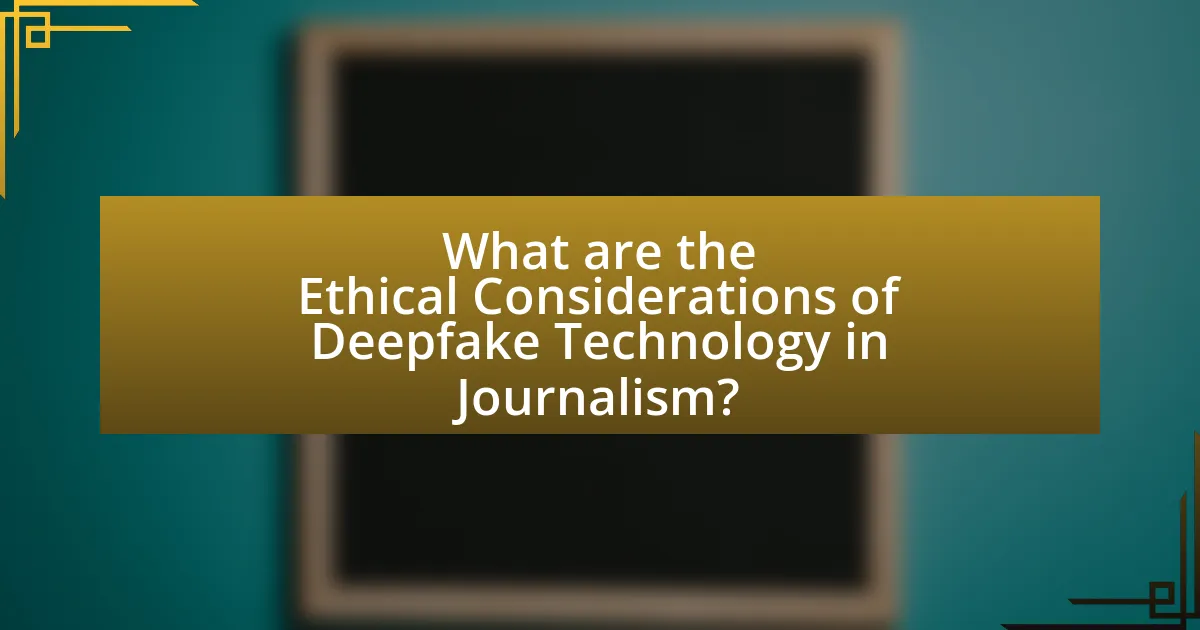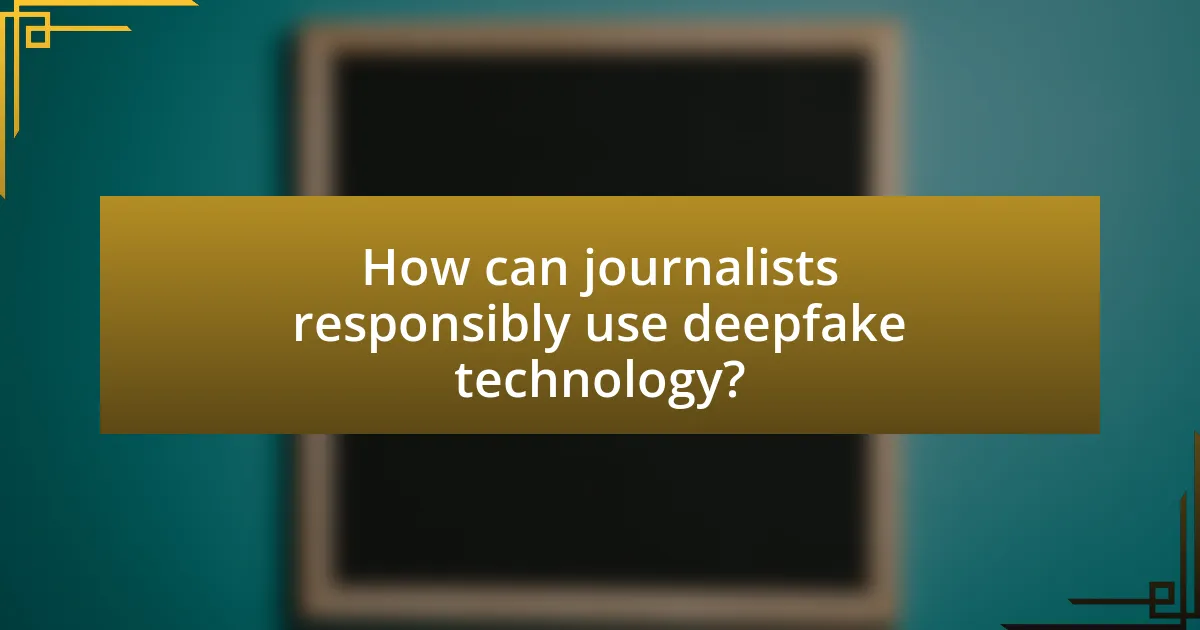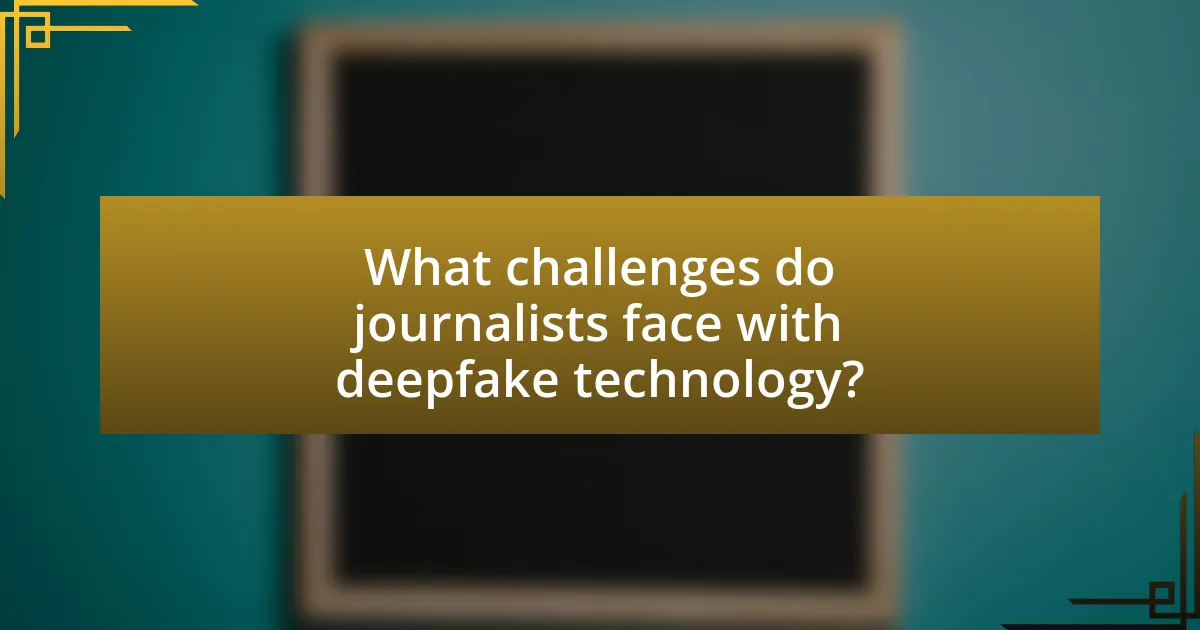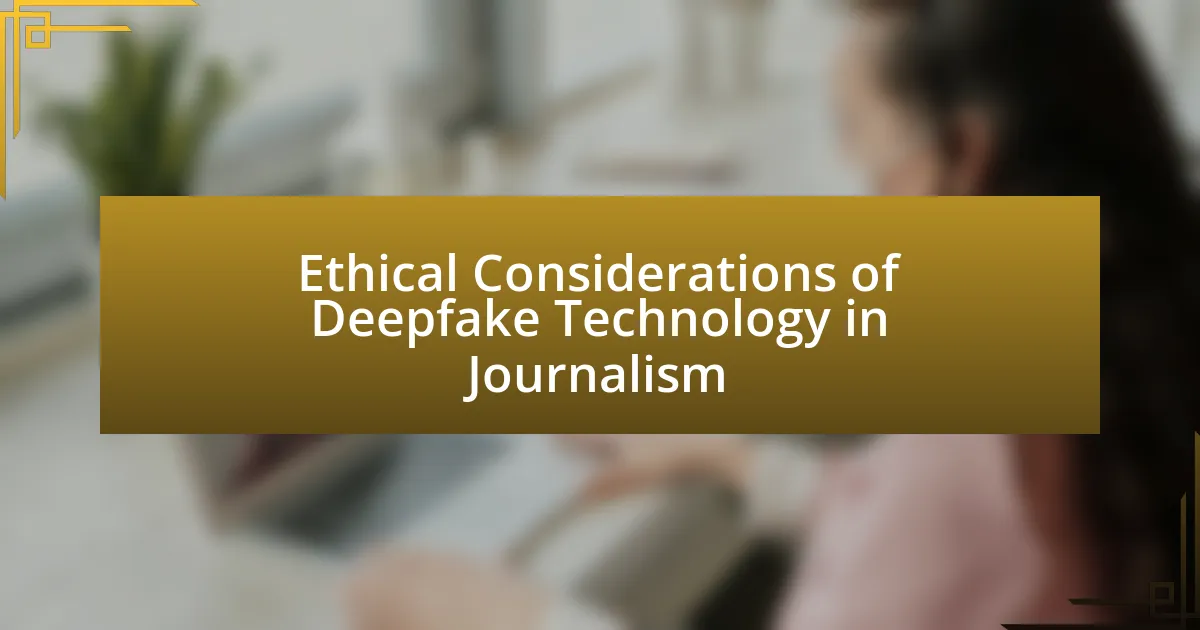The article examines the ethical considerations surrounding deepfake technology in journalism, focusing on issues of misinformation, trust, and accountability. It highlights how deepfakes can undermine journalistic integrity by creating realistic but fabricated content that misleads audiences and erodes public trust in media sources. The discussion includes the potential risks of misinformation, the ethical frameworks guiding the use of deepfakes, and the importance of transparency and accountability in reporting. Additionally, it addresses the societal challenges posed by deepfakes, including their impact on public opinion and the overall media landscape, while proposing practical steps for journalists to navigate these ethical dilemmas responsibly.

What are the Ethical Considerations of Deepfake Technology in Journalism?
The ethical considerations of deepfake technology in journalism primarily revolve around misinformation, trust, and accountability. Deepfakes can easily manipulate video and audio content, leading to the potential spread of false information that can mislead the public. For instance, a study by the University of California, Berkeley, found that deepfake videos could significantly influence viewers’ perceptions, raising concerns about the erosion of trust in media sources. Furthermore, journalists face ethical dilemmas regarding the use of deepfakes for satire or commentary, as this can blur the lines between fact and fiction, complicating accountability for the content produced. The implications of deepfake technology necessitate a reevaluation of ethical standards in journalism to ensure integrity and transparency in reporting.
How does deepfake technology impact journalistic integrity?
Deepfake technology undermines journalistic integrity by enabling the creation of highly realistic but fabricated audio and video content, which can mislead audiences and distort the truth. This technology poses significant risks, as it can be used to manipulate public perception, spread misinformation, and damage the credibility of legitimate news organizations. For instance, a study by the University of California, Berkeley, found that deepfakes can significantly decrease trust in media sources, with 70% of participants expressing skepticism towards video content after being exposed to deepfake examples. Such erosion of trust challenges the foundational principles of journalism, which rely on accuracy and accountability.
What are the potential risks of misinformation in journalism due to deepfakes?
The potential risks of misinformation in journalism due to deepfakes include the erosion of public trust, the spread of false narratives, and the manipulation of public opinion. Deepfakes can create highly convincing but fabricated audio and video content, making it difficult for audiences to discern truth from deception. For instance, a study by the University of California, Berkeley, found that deepfake videos can significantly influence viewers’ perceptions, leading them to believe in false events or statements attributed to public figures. This manipulation can undermine the credibility of legitimate journalism, as audiences may become skeptical of authentic news sources, fearing that they too could be disseminating false information.
How can deepfakes undermine public trust in media?
Deepfakes can undermine public trust in media by creating realistic but fabricated content that misleads audiences. This technology allows for the manipulation of video and audio, making it difficult for viewers to discern what is genuine. A study by the Massachusetts Institute of Technology found that 85% of participants could not identify deepfake videos, highlighting the potential for misinformation. As deepfakes proliferate, they can erode confidence in legitimate news sources, leading to skepticism about the authenticity of all media content.
What ethical frameworks can guide the use of deepfake technology in journalism?
Utilitarianism and deontological ethics are two primary ethical frameworks that can guide the use of deepfake technology in journalism. Utilitarianism focuses on the outcomes of actions, suggesting that deepfake technology should be used if it results in the greatest good for the greatest number, such as enhancing storytelling or providing critical insights. Conversely, deontological ethics emphasizes adherence to rules and duties, advocating for transparency and honesty in journalism, which would discourage deceptive uses of deepfake technology. These frameworks help navigate the moral complexities of employing deepfake technology, balancing innovation with ethical responsibilities to the audience and society.
Which ethical principles are most relevant to deepfake technology?
The ethical principles most relevant to deepfake technology include authenticity, consent, and accountability. Authenticity is crucial as deepfakes can mislead audiences by presenting fabricated content as real, undermining trust in journalism. Consent is significant because using someone’s likeness without permission raises ethical concerns regarding personal rights and privacy. Accountability is essential, as creators and distributors of deepfake content must be held responsible for the potential harm caused by misinformation. These principles are supported by the growing discourse on media ethics, emphasizing the need for responsible use of technology in journalism to maintain credibility and public trust.
How can journalists balance innovation with ethical responsibilities?
Journalists can balance innovation with ethical responsibilities by implementing strict guidelines that prioritize accuracy and transparency while embracing new technologies. For instance, when utilizing deepfake technology, journalists should ensure that any manipulated content is clearly labeled as such to prevent misinformation. Research from the Pew Research Center indicates that 86% of Americans believe it is important for news organizations to disclose when they use AI-generated content. This demonstrates a public expectation for ethical standards in journalism, reinforcing the need for journalists to maintain credibility while innovating. By adhering to ethical guidelines and prioritizing audience trust, journalists can effectively navigate the challenges posed by emerging technologies.
What are the implications of deepfake technology on freedom of expression?
Deepfake technology significantly impacts freedom of expression by enabling the creation of highly realistic but fabricated audio and video content, which can distort truth and manipulate public perception. This manipulation poses risks to the integrity of information, as individuals may be misled by deepfakes that appear credible, undermining trust in legitimate expressions and media. For instance, a study by the University of California, Berkeley, found that deepfakes can lead to misinformation campaigns that influence political opinions and social discourse, thereby threatening democratic processes. Furthermore, the potential for deepfakes to be used in harassment or defamation cases raises ethical concerns about the boundaries of expression and the protection of individuals’ rights.
How might deepfakes affect the boundaries of free speech in journalism?
Deepfakes may blur the boundaries of free speech in journalism by enabling the creation of misleading or false narratives that can undermine trust in media. This technology allows for the manipulation of video and audio content, making it increasingly difficult for audiences to discern fact from fiction. For instance, a study by the University of California, Berkeley, found that deepfake videos can significantly influence public perception and opinion, raising concerns about misinformation and its impact on democratic discourse. As a result, the proliferation of deepfakes could lead to stricter regulations on speech in journalism, as media outlets may face pressure to verify content more rigorously to maintain credibility.
What role do regulations play in managing deepfake technology in media?
Regulations play a crucial role in managing deepfake technology in media by establishing legal frameworks that deter misuse and protect individuals’ rights. These regulations aim to combat misinformation, safeguard privacy, and ensure accountability for creators of deepfakes. For instance, laws such as the Malicious Deep Fake Prohibition Act in the United States specifically target the malicious use of deepfake technology, making it illegal to create or distribute deepfakes with the intent to harm or defraud. Additionally, the European Union’s proposed Digital Services Act seeks to impose stricter guidelines on platforms hosting user-generated content, thereby holding them accountable for the dissemination of harmful deepfakes. Such regulations are essential for maintaining ethical standards in journalism and protecting the integrity of media.

How can journalists responsibly use deepfake technology?
Journalists can responsibly use deepfake technology by ensuring transparency, verifying the authenticity of the content, and adhering to ethical guidelines. Transparency involves clearly labeling deepfake content to inform audiences that it has been altered, which helps maintain trust. Verification requires journalists to fact-check and confirm the accuracy of the deepfake before publication, as evidenced by the rise in misinformation associated with manipulated media. Ethical guidelines, such as those established by the Society of Professional Journalists, emphasize the importance of minimizing harm and ensuring that the use of deepfakes serves the public interest rather than sensationalism.
What guidelines should journalists follow when using deepfake technology?
Journalists should adhere to strict ethical guidelines when using deepfake technology, ensuring accuracy, transparency, and accountability. First, they must verify the authenticity of the content before publication, as misinformation can lead to public distrust and harm. Second, journalists should disclose the use of deepfake technology to their audience, providing context about its purpose and creation to maintain transparency. Third, they must consider the potential impact on individuals and society, avoiding the creation of misleading narratives that could cause harm or perpetuate falsehoods. Lastly, adherence to legal standards and ethical codes, such as those outlined by the Society of Professional Journalists, is crucial to uphold journalistic integrity. These guidelines are essential to navigate the complexities of deepfake technology responsibly.
How can transparency be maintained when utilizing deepfakes in reporting?
Transparency can be maintained when utilizing deepfakes in reporting by clearly labeling content as manipulated and providing context about its creation. This approach ensures that audiences are aware of the artificial nature of the material, which is crucial for ethical journalism. For instance, news organizations can implement guidelines that require explicit disclosures whenever deepfake technology is used, similar to how they cite sources or clarify editorial choices. This practice aligns with the principles of accountability and trust in journalism, as evidenced by the growing emphasis on media literacy and the need for audiences to critically evaluate information sources.
What are best practices for disclosing the use of deepfake technology?
Best practices for disclosing the use of deepfake technology include clear and transparent communication about the technology’s application, ensuring that audiences are informed about the nature of the content. Journalists and creators should label deepfake content explicitly, indicating that it has been digitally altered, which aligns with ethical standards in journalism that prioritize truthfulness and accountability. Research from the Pew Research Center indicates that 86% of Americans believe it is important for media outlets to disclose when they use AI-generated content, reinforcing the necessity for transparency. Additionally, providing context about the purpose of the deepfake, such as whether it is for satire, education, or misinformation, further aids in audience understanding and trust.
What are the potential benefits of deepfake technology in journalism?
Deepfake technology can enhance journalism by enabling more engaging storytelling and improving the accessibility of information. This technology allows journalists to create realistic simulations of events or interviews, which can help illustrate complex narratives and provide visual context. For instance, deepfakes can be used to recreate historical events for educational purposes, making them more relatable and understandable for audiences. Additionally, deepfake technology can facilitate the production of content in multiple languages, broadening the reach of journalistic work. The potential for increased audience engagement and understanding underscores the value of deepfake technology in modern journalism.
How can deepfakes enhance storytelling in news media?
Deepfakes can enhance storytelling in news media by providing immersive and engaging visual narratives that can illustrate complex issues more effectively. For instance, deepfake technology allows for the creation of realistic simulations of events or interviews, enabling audiences to visualize scenarios that may be difficult to convey through traditional reporting. This capability can lead to a deeper emotional connection with the content, as seen in projects like “The New York Times’ ‘The Truth is Hard’ campaign,” which utilized deepfake technology to present historical figures discussing contemporary issues, thereby contextualizing news stories in a compelling manner. Such applications demonstrate how deepfakes can serve as powerful tools for enhancing the storytelling aspect of journalism while also raising ethical considerations regarding authenticity and misinformation.
What innovative uses of deepfake technology can improve audience engagement?
Innovative uses of deepfake technology that can improve audience engagement include personalized content creation, interactive storytelling, and enhanced virtual experiences. Personalized content creation allows media outlets to tailor news presentations to individual viewer preferences, increasing relevance and interest. Interactive storytelling can engage audiences by allowing them to influence narrative outcomes through their choices, making the experience more immersive. Enhanced virtual experiences, such as realistic avatars of journalists delivering news, can create a stronger emotional connection with the audience. These applications leverage deepfake technology’s ability to create lifelike representations, which can significantly enhance viewer retention and interaction rates.

What challenges do journalists face with deepfake technology?
Journalists face significant challenges with deepfake technology, primarily concerning misinformation and credibility. The rise of deepfakes complicates the verification process, as these manipulated media can convincingly depict false events or statements, leading to potential public deception. A study by the University of California, Berkeley, highlights that 96% of surveyed journalists expressed concern about the impact of deepfakes on their ability to report accurately. Additionally, the legal implications surrounding deepfakes pose challenges, as journalists must navigate issues of copyright and defamation while ensuring ethical reporting standards are maintained.
What are the technical challenges associated with deepfake technology in journalism?
The technical challenges associated with deepfake technology in journalism include the difficulty in detecting manipulated content, the need for advanced algorithms to create realistic deepfakes, and the potential for misinformation. Detecting deepfakes requires sophisticated machine learning techniques, as traditional methods often fail to identify subtle alterations in video and audio. Research indicates that as deepfake technology evolves, so do the techniques for detection, creating an ongoing arms race between creators and detectors. Additionally, the computational resources required for generating high-quality deepfakes can be significant, posing barriers for journalists with limited access to technology. The risk of spreading misinformation is heightened, as deepfakes can easily mislead audiences, undermining trust in media sources.
How can journalists verify the authenticity of deepfake content?
Journalists can verify the authenticity of deepfake content by utilizing advanced detection tools and cross-referencing information with credible sources. Detection tools, such as Deepware Scanner and Sensity AI, analyze video and audio for inconsistencies that indicate manipulation. Cross-referencing involves checking the content against verified footage or statements from reliable sources, ensuring that the context and claims made in the deepfake align with established facts. Studies have shown that these methods can significantly reduce the risk of disseminating false information, as they leverage technology and journalistic integrity to uphold accuracy in reporting.
What tools are available to detect deepfakes in news reporting?
Tools available to detect deepfakes in news reporting include Deepware Scanner, Sensity AI, and Microsoft Video Authenticator. Deepware Scanner utilizes machine learning algorithms to analyze videos for signs of manipulation, while Sensity AI focuses on identifying deepfake content through a combination of computer vision and deep learning techniques. Microsoft Video Authenticator assesses images and videos to provide a confidence score regarding their authenticity. These tools are designed to combat misinformation and enhance the credibility of news reporting by providing reliable detection methods.
What societal challenges arise from the use of deepfake technology in journalism?
The use of deepfake technology in journalism presents significant societal challenges, primarily including the erosion of trust in media, the potential for misinformation, and the risk of reputational harm to individuals. As deepfakes become more sophisticated, audiences may struggle to discern between authentic and manipulated content, leading to skepticism towards legitimate news sources. A study by the Pew Research Center found that 64% of Americans believe that fabricated news stories cause confusion about the facts, highlighting the widespread concern regarding misinformation. Furthermore, deepfakes can be weaponized to create false narratives about public figures, resulting in reputational damage and potential legal consequences. These challenges underscore the urgent need for ethical guidelines and technological solutions to mitigate the impact of deepfake technology in journalism.
How do deepfakes contribute to the polarization of public opinion?
Deepfakes contribute to the polarization of public opinion by creating misleading and manipulated content that can reinforce existing biases. This technology allows for the fabrication of realistic videos and audio, which can misrepresent individuals’ statements or actions, leading to misinformation. Research indicates that exposure to deepfake content can increase distrust in media sources and heighten partisan divides, as individuals are more likely to accept information that aligns with their pre-existing beliefs. For instance, a study published in the journal “Nature” found that individuals exposed to deepfake videos were more likely to express polarized views on political issues, demonstrating how such technology can exacerbate divisions within society.
What impact do deepfakes have on the overall media landscape?
Deepfakes significantly disrupt the overall media landscape by undermining trust in visual content. The proliferation of deepfake technology enables the creation of hyper-realistic but fabricated videos, which can mislead audiences and manipulate public perception. A study by the University of California, Berkeley, found that 96% of deepfake videos are pornographic, but the technology’s potential for misinformation extends to political and social contexts, as seen during election cycles where manipulated videos can sway voter opinions. This erosion of trust complicates the ability of journalists and media organizations to verify information, leading to increased skepticism among audiences regarding authentic content.
What practical steps can journalists take to navigate the ethical landscape of deepfake technology?
Journalists can navigate the ethical landscape of deepfake technology by implementing rigorous verification processes for content authenticity. This includes utilizing advanced detection tools that analyze video and audio for signs of manipulation, as studies have shown that such tools can significantly reduce the risk of disseminating false information. Additionally, journalists should maintain transparency with their audience by clearly labeling deepfake content and providing context about its creation and purpose. Research from the Pew Research Center indicates that public awareness of deepfake technology is crucial, as informed audiences are better equipped to critically assess media. Furthermore, establishing ethical guidelines within news organizations that address the use of deepfakes can help ensure responsible reporting practices.

Leave a Reply